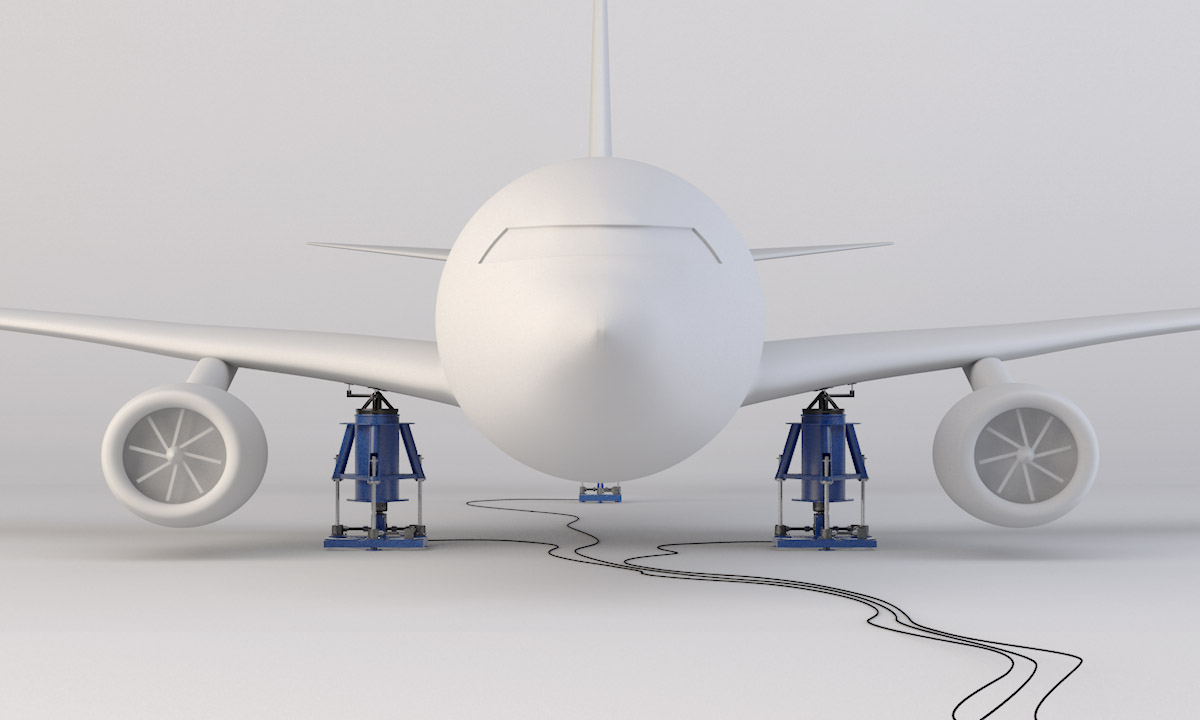




A concrete support structure (foundation, inertia block, reaction mass) is used to satisfy one or more of the following conditions:
1). Provide/improve structural stiffness for the machine/equipment being isolated. Some types of equipment do not operate properly unless supported by a rigid structure. This applies to certain types of machine tools that are not inherently rigid and therefore need a rigid support to maintain the prescribed accuracy. In other types of machinery (such as printing presses) consisting of articulated components, a rigid support may be needed to maintain the proper alignment of working parts.
2). Increase stability on the vibration isolators by limiting dynamic deflection. If a machine (such as a diesel engine, forging hammer or electro-dynamic shaker) generates relatively large forces during its operation, the overall movement of the machine on its isolation system tends to become excessive unless its effective mass is substantially increased. This increase in effective mass can be achieved by attaching the machine rigidly to an inertia block and mounting the inertia block (reaction mass) on isolators.
3). Isolate the equipment/machine from the environment when installing isolators directly beneath the unit would compromise the conditions above. In applications in which the frequency of excitation is low, the natural frequency of the isolation system must be very low to provide low transmissibility and therefore good vibration isolation. A problem often arises with a machine intended to be mounted only at its base, because a low-stiffness base-mounted system tends to be unstable and will allow excessive motion to take over.
Technical Specifications
Pneumatic isolators are installed after the foundation has cured and the machine/equipment has been installed and anchored properly. The isolators are positioned under the foundation at predetermined support points and then activated to float or lift the foundation and machine off the pit floor.
The desired natural frequency (stiffness) and damping for the isolation system is usually established by the operating characteristics of the mounted equipment (source) and/or the isolation required (recipient). The design basis for the support foundation natural frequency assumes that the foundation is a rigid body with a stiffness much greater than the isolators. Similarly, the pit base also should be stiffer than the soil supporting it.
For large machine tools and CMM’s using automatic part handling systems where parts can weigh several tons, loading and unloading can generate vertical motion on the isolators. To avoid this problem, Fabreeka can vary the internal pressure of the isolators to lower the support foundation onto hard stops.
In certain applications, it is not desirable or feasible to mount a machine directly on vibration isolators.
Direct installation of vibration isolators on a machine whose frame/bed stiffness is inadequate for such, can cause bending, relative displacement and other problems, even when the floor is sufficiently rigid. For smaller machines, this can be remedied by securing the frame/bed to a rigid plate and then installing the isolators between the plate and the floor. For larger machines, the frame/bed is attached to a properly designed concrete foundation, which is then supported on the appropriate isolators for the application.
Fabreeka designs and manufactures large capacity pneumatic and air bag isolators, which support loads from 13,000 lbs (5,800 kg) to 120,000 lbs (54,000 kg) each for foundation isolation applications requiring low frequency vibration isolation. Air bag isolators provide a larger dynamic stroke than our standard PAL isolators and are used in applications where a low natural frequency (0.5 – 1.5 Hz) and large displacements must co-exist.


How many pneumatic isolators do I use to support the inertia mass (reaction mass)?
The inertia mass should be supported on its two longest sides and the spacing between isolators is normally 5 – 8 feet. The isolators may need to be closer depending on inertia mass depth and stiffness requirements.
How can I calculate how much dynamic deflection the pneumatic isolator or airbag will have?
The calculation can be made through a dynamic analysis, which Fabreeka routinely conducts for our proposed solutions. The dynamic deflection is function of isolator/dynamic spring rate and the frequency and magnitude at which the input occurs.
When should I use an airbag and when should I use a PAL-type pneumatic isolator?
PAL-type isolators should be used in all cases where the dynamic deflection is 1/2″ or less. Airbag isolators should be used if the dynamic deflection is more than 1/2″.
How can I calculate the structural frequencies of my inertia mass (reaction mass)?
The structural frequencies can be determined using FEA software. Fabreeka can provide this service if this software is not available to you.
Is there anything special about the design of the pit and inertia mass (foundation) I should know about?
Besides the normal structural requirements considering static and dynamic loads and soil conditions, an isolated inertia mass must be designed with structural modes that are higher than the disturbing frequencies and the natural frequency of the isolators. The inertia mass will amplify the vibration, if the modes are near these frequencies (in resonance). The inertia mass must be dynamically stiff enough not to be in resonance with the isolator frequency and any disturbing frequencies. The pit must be designed based on a soil analysis to insure it is dynamically stiff enough to support the mass.